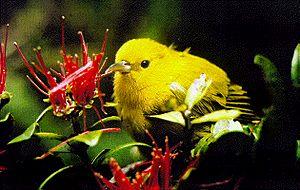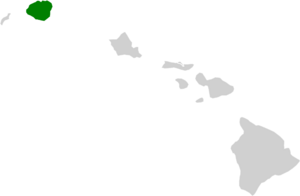ʻAnianiau facts for kids
The ʻanianiau (pronounced ah-nee-ah-nee-OW) is a small, bright yellow bird. It is a type of Hawaiian honeycreeper. This special bird lives only in the high forests on the island of Kauai in Hawaii. It is unique because it's the only species in its group, called Magumma.
Quick facts for kids ʻAnianiau |
|
|---|---|
 |
|
 |
|
| Female ʻanianiau | |
| Conservation status | |
| Scientific classification | |
| Genus: |
Magumma
|
| Species: |
parva
|
 |
|
| Synonyms | |
|
Hemignathus parvus |
|
Contents
What Does the ʻAnianiau Look Like?
The ʻanianiau is a very bright yellow bird. It is the smallest Hawaiian honeycreeper. It is only about 10 centimetres (3.9 in) long. This is about the length of your hand! It weighs around 10 grams, which is like two quarters.
The ʻanianiau has a slightly curved beak. Male birds are a bright yellow color. Female birds are a duller yellow-green. Their feathers are not as bright as the males'.
When it calls, it makes a sound like tew-weet. Its song is a quick trill that sounds like wee-see, wee-see, wee-see.
Where Does the ʻAnianiau Live?
ʻAnianiau birds live in moist and wet forests. These forests are found high up on mountains. They live at elevations above 600 m (2,000 ft). You can find the most ʻanianiau birds above 1,100 m (3,600 ft).
The trees in their home include koa (Acacia koa). They also live near ʻōhiʻa lehua (Metrosideros polymorpha), ʻōlapa (Cheirodendron trigynum), and lapalapa (C. platyphyllum) trees.
What Does the ʻAnianiau Eat?
The ʻanianiau mostly drinks nectar from flowers. They love the nectar from ʻōhiʻa lehua (Metrosideros polymorpha) flowers. They also drink from ʻōhelo (Vaccinium spp.) and ʻalani (Melicope spp.) plants.
Sometimes, they also eat small arthropods. These tiny creatures are found on trees, bushes, and vines.
The ʻAnianiau Life Cycle
The ʻanianiau birds have their babies from February to June. The female bird builds a small, cup-shaped nest. She uses twigs and lichens to build it. The nest is usually found in an ʻōhiʻa tree.
Usually, the female lays three eggs. The small yellow chicks hatch and leave the nest in about three weeks. While they are in the nest, their parents feed them mostly caterpillars. This helps them grow strong.
When Was the ʻAnianiau Discovered?
People first found the ʻanianiau in the 1830s. But then, no one saw it again for about 50 years! Scientists did not study this bird very much until the 1960s.
Protecting the ʻAnianiau
The area where the ʻanianiau lives has shrunk a lot. It used to live in almost all the forests on Kauai. Now, its home is 85% smaller.
The biggest problems for this bird are:
- Its home being damaged.
- New plants coming in that are not native to Hawaii. These non-native plants can take over.
Diseases carried by mosquitoes, like avian malaria, are not a big problem for them. This means these diseases do not cause many deaths. It is possible that rats and cats hunt these birds. However, scientists have not seen this happen often.
The ʻanianiau is protected in a few special places. These include the Alakai Wilderness Preserve and the areas around it. They are also protected in Waimea Canyon and Kokeʻe State Parks. These parks help keep their homes safe.


